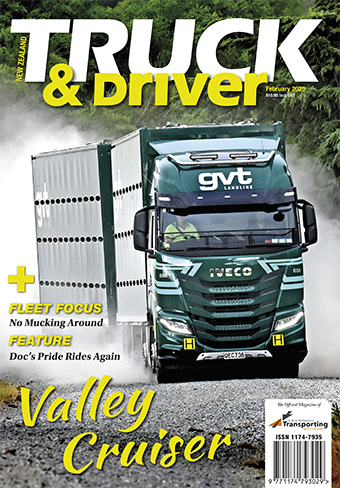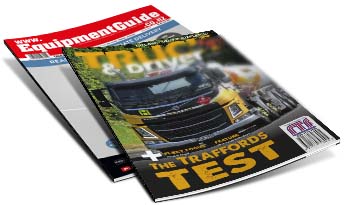Double Coin Imaging Awards


Trial and error creates winner
Double Coin Imaging Awards
Some fleet colour schemes come fully-formed and ready to go, from a professional design consultancy – while others are the result of several years of experimentation.
This month's finalist in the PPG Transport Imaging Awards, Christchurch's SML Logging, fits quite firmly into the latter category.
Its first decade featured a range of variants that were not always universally admired, but which eventually evolved into the smart livery that today makes the fleet one of the most recognisable in the region.
The positive public identity is boosted by a tradition begun by founder Steve Murphy and enthusiastically carried on by son and company co-owner Chris. Every Saturday the Murphys join the drivers in washing the whole 40-plus fleet, which is then lined up with military precision in the company's spacious yard near Kaiapoi.
Some fleet colour schemes come fully-formed and ready to go, from a professional design consultancy – while others are the result of several years of experimentation.
This month's finalist in the PPG Transport Imaging Awards, Christchurch's SML Logging, fits quite firmly into the latter category.
Its first decade featured a range of variants that were not always universally admired, but which eventually evolved into the smart livery that today makes the fleet one of the most recognisable in the region.
The positive public identity is boosted by a tradition begun by founder Steve Murphy and enthusiastically carried on by son and company co-owner Chris. Every Saturday the Murphys join the drivers in washing the whole 40-plus fleet, which is then lined up with military precision in the company's spacious yard near Kaiapoi.
With the Northern Motorway running along one boundary and set higher than the depot, passing travellers are regularly treated to an impressive display.
Steve sees this as a core of the company's image: "The fleet presentation not only gives us a sense of pride, but the drivers love it too. And it's good advertising for the industry in general.
"Sometimes it can get a little disheartening to have around 14 people on the weekend cleaning the fleet from bumper to bumper, then by eight on Monday morning in winter you'd hardly know they've been washed! But if you don't keep it up you end up with a massive job."
The fleet's beginnings, in terms of both numbers and livery, were much more modest, recalls Steve: "My first truck, in the early '80s, was a 237 horsepower F-Series Mack, a 1973 model. When I bought it, it was painted in a mustard-yellow colour.
"I was contracting to the local Odlins Timber sawmill at the time, and that company's colour scheme was based on an unexciting green. They wanted me to paint the truck the same way, but I negotiated a compromise – painting the cab white and putting on a couple of stripes in Odlins Green."
The base respray job was carried out in the shed behind the Murphy home that acted as a depot for the fledgling operation.
The DIY approach to fleet livery was to continue for some time, says Steve: "I painted the chassis of the second truck we ran – a W924 Kenworth – in an Empire Blue. It was a nice fresh colour that always looked good, even when it was a bit dirty, so I carried it through to the front guards as well. That's the same colour we still have on the chassis and guards."
The Odlins contract lasted a couple of years, after which he was free to flex his design muscle. Out went the green, replaced with a broad stripe either side. Originally Steve went for a shade called Arabian Gold, with the same colour for the signwriting on the doors. It was, he recalls, a far from stellar decision: "The gold and the blue really clashed! They didn't look good at all."
The next evolution of the scheme came with an R-Model Mack. Originally it was given the gold stripes as well, but the result reinforced the decision that a change was needed, so he swapped to a dark, almost royal, blue. That didn't meet with universal approval, either, he says: "I was putting the truck over the weighbridge and the operator said it looked like a pack of Cambridge cigarettes.
"So I went back home and added a red keyline around the blue. When I returned to the weighbridge for approval, the opinion was that it now looked like shit!
"So it was back to the drawing board. In the shed I had a range of blue and white enamel paints, including a metallic blue Duco, so I mixed them together, put it in the gun, and sprayed it over the existing dark blue stripes. The result was not too bad, so I sprayed some on a sheet and took it into Colour Services and asked if they could match it.
"They came up with Sapphire Blue, which was the same as a Quartz Metallic Blue that at the time was being offered on Honda cars."
At the same time a shade called Banderillero Red was settled on for the border to the blue, and both colours have been carried through to today.
As Steve points out, it was an evolutionary process – taking a decade or more: "For our first half-dozen trucks I was still doing the painting, so it was a simple matter to tweak things here and there."
The only major change in the past 25 years was a swap in the early 2000s from the 'Steve Murphy Limited' branding to 'SML' and a logo incorporating stylised trees.
Steve has long ago hung up his spray gun, handing the job over to professionals. Bairds Collision Centre in Hornby does the fleet's painting, both applying the fleet blue to the white cabs of new vehicles and looking after maintenance and repair work, while Horton Signs in Rangiora handles the signwriting and detail finishing.




 + EQUIPMENT GUIDE - FREE
+ EQUIPMENT GUIDE - FREE
